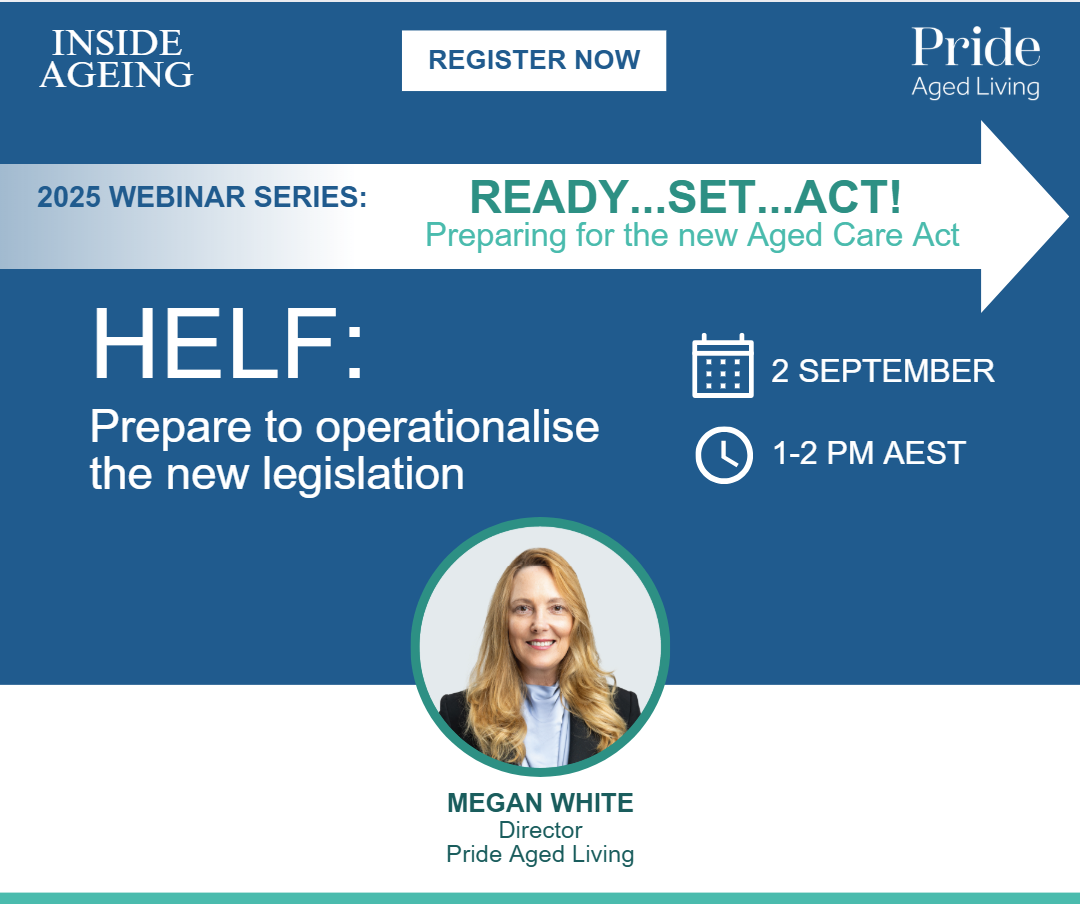Is it worth implementing HELF, or do you increase your accommodation price?

With the removal of Additional Services (AS) and Extra Services (ESS), the introduction of Higher Everyday Living Fee (HELF), and retentions applying to RADs, some providers are assessing whether to:
• Increase accommodation prices (RADs) to cover lost ESS and AS revenue
• Transition from AS/ES to HELF or
• Introduce new HELF programs
The key question is -
Which approach provides the best operational and financial outcome with the least risk?
To assist providers grappling with this issue, we have developed the following case study from a real-life situation.
Case study background
A multi-site aged care provider currently generating approximately $4 million in revenue from their Additional Services (AS) program was concerned about the long-term viability of the Higher Everyday Living Fee (HELF) model, given its optional basis compared to the effective mandatory AS model they currently operate.
They were considering dropping the AS program and increasing their accommodation price to cover the lost AS revenue rather than implementing a HELF program.
We worked with them to model what a HELF program could achieve and the level of increase they would need in their RAD to compensate for this income.
We modelled three scenarios:
Option 1: Drop Additional Services
The run-off impact of their current AS clients based on the average length of stay.
Option 2: Implement HELF
The expected income from a HELF program based on:
- An average HELF fee ($20)
- Take-up rates of 50% and 75% of all residents
- A concessional HELF fee of $8.95 for supported residents
Option 3: Increase RAD
The increase in RAD required to generate revenue equivalent to the lost 2024-25 AS income, considering:
- The earning rate on their invested RAD
- The percentage of RAD payers
- The 2% RAD retention
What we learned
To make the case study easy to apply to your situation, we’ve reduced all the numbers to apply to a 100-place facility.
Option 1: Annual expected revenue loss without replacing Additional Services
Without a HELF program, the AS program revenue is projected to decline to zero by 2026-27. That’s a loss of $10.60 per resident per day.
| Current AS Program | 2024-25 | 2025-26 | 2026-27 |
| Revenue | $387,000 | $240,000 | $0 |
Option 2: Potential revenue based on Pride Aged Living HELF
Our modelling suggests a provider can expect a HELF program with 50% take up to deliver between 87% (131% at 75% take up) of AS program income within 4 years.
| AS/HELF income | 2025-26 | 2026-27 | 2027-28 | 2028-29 |
| 75% take up | $436,000 | $426,000 | $477,000 | $506,000 |
| 50% take up | $370,000 | $285,000 | $319,000 | $337,000 |
| AS/HELF income PRPD | ||||
| 75% take up | $11.35 | $11.09 | $12.42 | $13.17 |
| 50% take up | $9.63 | $7.42 | $8.30 | $8.77 |
| HELF income compared to 2025 AS program income (%) | ||||
| 75% take up | 113% | 110% | 123% | 131% |
| 50% take up | 95.6% | 73.6% | 82.4% | 87.1% |
2025-26 and 2026-27 see slower growth due to the drop-off in AS revenue and replacement with a lower HELF fee that applies to all residents.
Option 3: Increasing RAD Pricing
We used the following assumptions to estimate the increase in RAD required to replace the 2025 AS income.
- 7% long-term MPIR
- 60% of RAD payers pay full RAD
- 2% RAD retention
- 40% supported ratio
The September 2024 Aged Care Financial Performance Survey suggests the average RAD is approximately $488,000.
Our modelling suggests an average provider would need to increase their RAD from $488,000 to $647,000 – an increase of 22% to 33%. Is this realistic?
To replace HELF income in 2028-29, the required RAD increase is approximately $159,000 with 75% take-up, or $105,000 with 50% take-up of the HELF program.
Even if a $159,000 increase in RAD is possible, this suggests that current accommodation pricing is sub-optimised, and this should be addressed independently of what decision is made on HELF.
There are risks to be considered when increasing RAD prices:
- Loss of competitiveness in the local market –
If this happens, then occupancy will fall, and the impact of not operating a HELF program will be far greater. - Higher RAD approval requirements –
If your current RAD is over $600,000, increasing this by $159,000 will take the new RAD above the $750,000 threshold to get a higher RAD approval . Recent approvals we have sought for clients confirm this not always straight forward. RAD investment returns and adjustments –
If RAD investment returns are lower than our modelling, the increase in the RAD will need to be greater.
Relative Risk
Every decision involves weighing risk and reward. The goal is to strike the right balance.
| Risk | Impact | Mitigation approaches |
| Low HELF program take-up |
|
|
| Increased RAD pricing |
|
|
| Competitors offering HELF |
|
|
| Underachieving RAD investment performance |
|
|
When comparing the relative risks of the two approaches, introducing a HELF program involves less risk. The worst outcome is lower-than-expected revenue.
By contrast, increasing your RAD to compensate for the loss of AS/ES revenue involves multiple risks and incorrectly assumes there is sufficient margin in accommodation to support hospitality services.
This suggests the 2% RAD retention and any increase in RAD/DAP should be directed toward making accommodation sustainable, rather than subsidising hospitality services.
Relying on higher RADs to replace AS program income appears to be a high-risk strategy.
Conclusion
Based on this case study, we arrive at the following conclusions:
- Even allowing for a lower take-up, well-structured HELF programs have the potential to generate similar or more revenue than AS programs.
- The Department has flagged, and the policy settings reinforce, the need to optimise the outcome in both accommodation and hospitality.
- Not implementing a HELF program would seem to be shortsighted. Not transitioning to HELF and relying solely on increased accommodation charges is a high-risk approach.
Relying on just one strategy - either increasing RADs or switching to HELF - will not optimise your future revenue.
Navigate change with the right approach
Sound business models will include HELF programs and optimisation of accommodation charges.
Now is the time to reset your approach and maximise outcomes from both accommodation and hospitality services.
Our HELF transition and implementation services are designed to streamline your journey, ensure compliance, and position your organisation for success under the new regulations.
Accommodation Optimisation
Our Accommodation Optimisation Services provide expert analysis of your accommodation revenue streams to help you identify missed opportunities for income generation and ensure your accommodation services are financially sustainable.
Our unique three-factor model balances Affordability, Competitiveness, and Return on Investment, resulting in high occupancy at the optimum price from both the consumer and provider perspectives.
See our Accommodation Optimisation Services
Join our webinar
We’re hosting a webinar with Inside Ageing on 2 September (rescheduled from 12 June): 'HELF: Prepare to operationalise the new legislation’

With 1 July just around the corner, is your organisation ready for the shift to the Higher Everyday Living Fee (HELF) and the changes in compliance management that come with it? We know that many organisations will need to review and adjust their approach to admissions and enhance service delivery processes.
Join us for a final preparation webinar designed to ensure you’re fully equipped for a smooth transition.
We’ll cover the essential steps you should have completed by now, highlight any last-minute checks, and offer guidance on executing your HELF transition effectively.
This session will walk you through key actions to take, potential pitfalls to avoid, and how to ensure compliance as the new Aged Care Act takes effect. Don’t miss this critical opportunity to fine-tune your strategy and guarantee a successful transition on 1 July.
Topics we’ll cover:
• The Rules, final versions and implications
• Checklist
• Implementation pitfalls
• Ongoing responsibilities for AS and ESS residents
To learn more about the webinar and register, click here.
To find out how we can assist your organisation with Extra Services, Additional Services and Higher Everyday Living Fees, contact Megan.
Megan White
02 9068 0777
megan.white@prideagedliving.com.au
To find out how we can assist your organisation with accommodation outcome, contact George
George Suharev
02 9068 0777
george.suharev@prideagedliving.com.au


